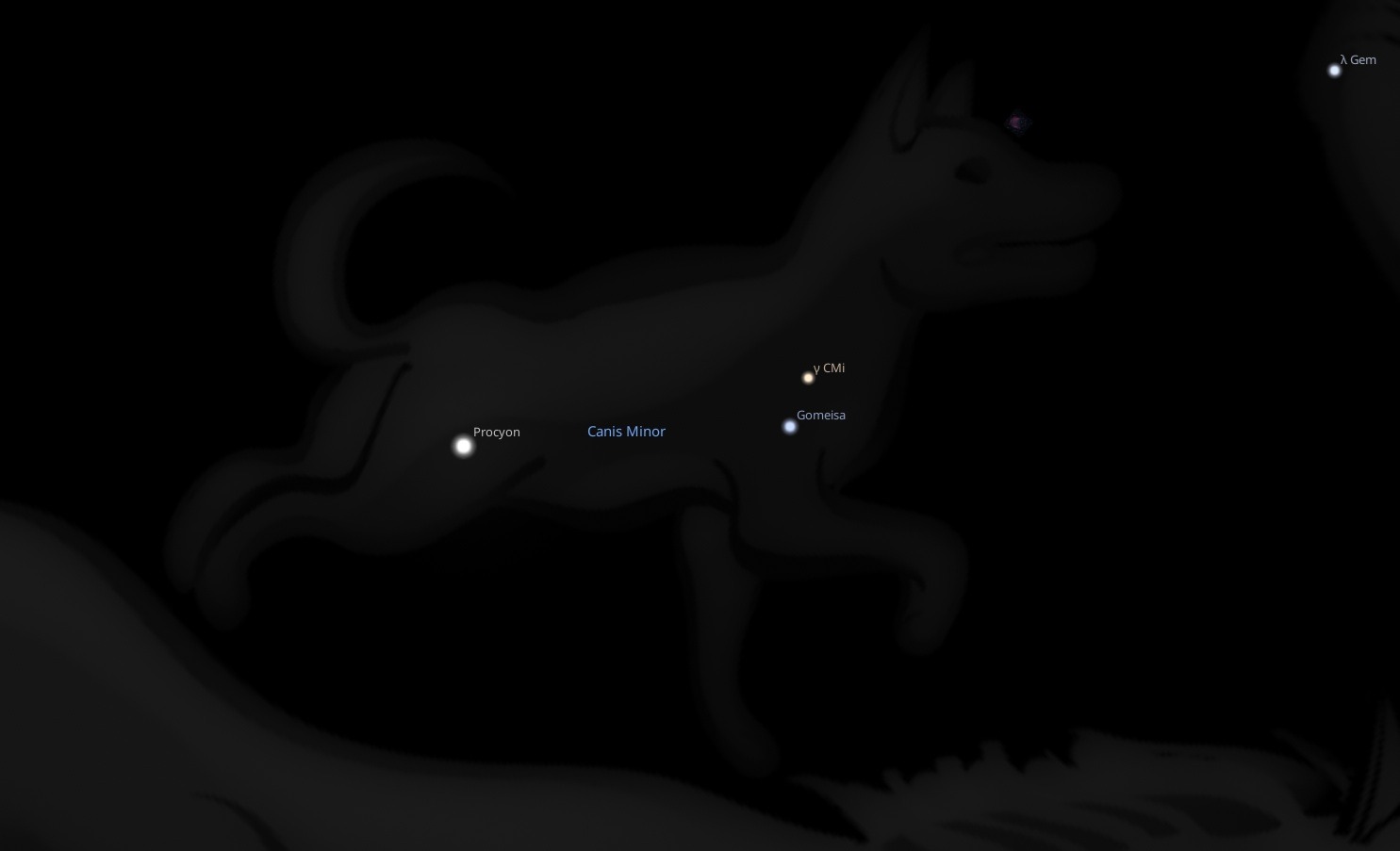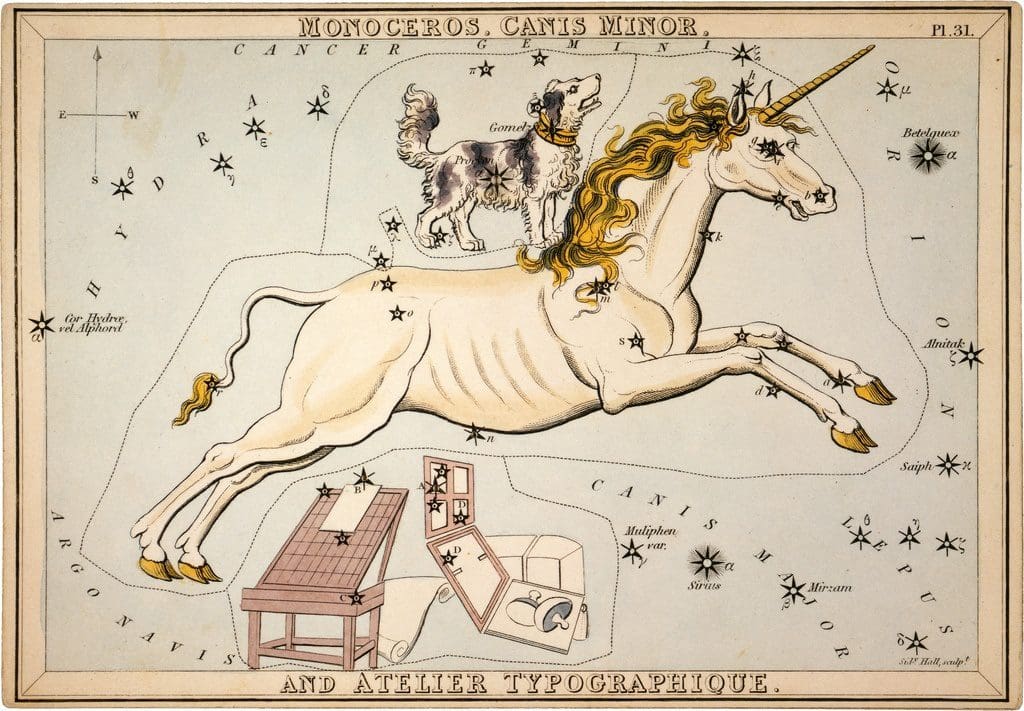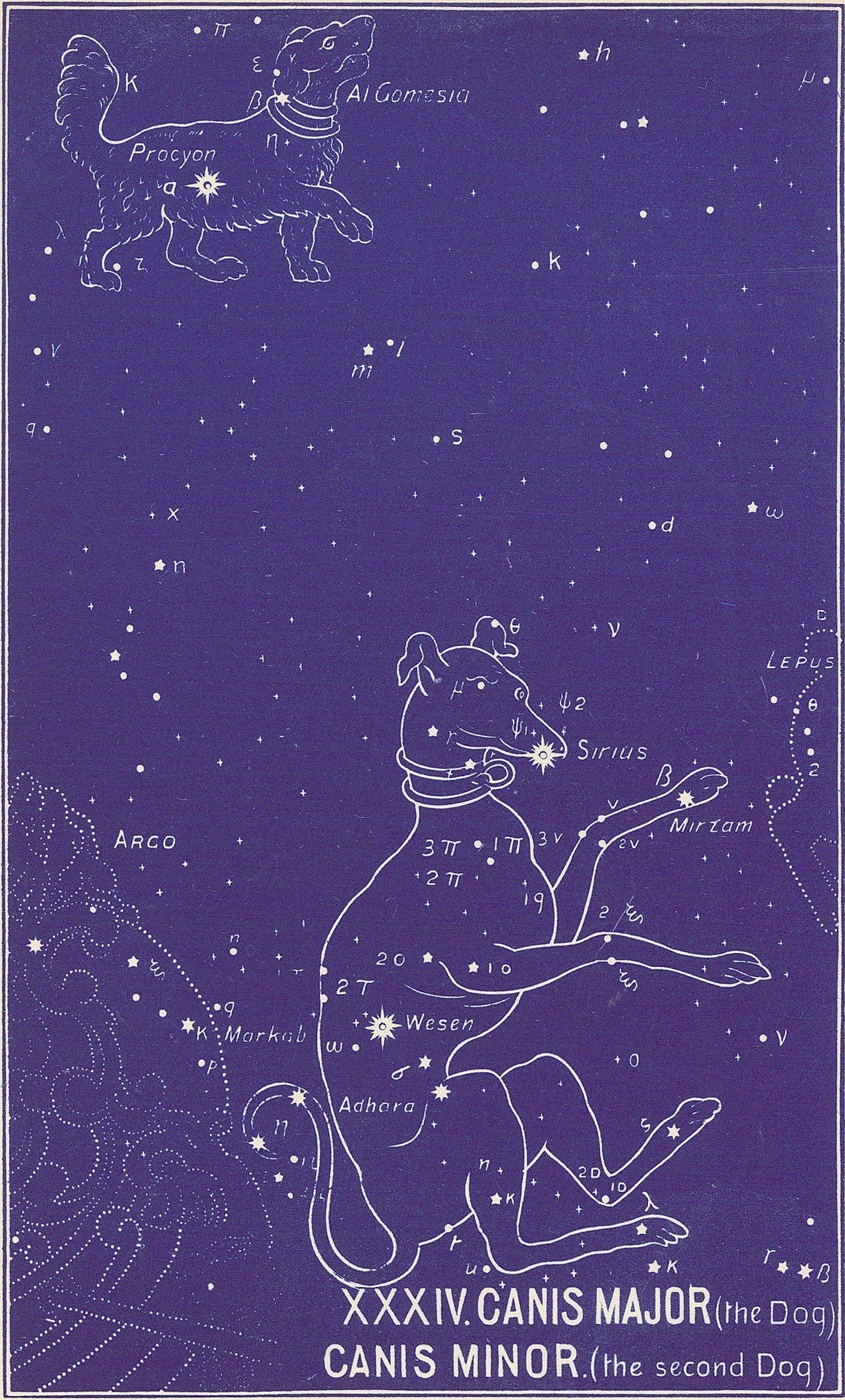FIXED STARS: Major Stars | 1000+ Stars | Constellations | About
Constellation Canis Minor, the Lesser Dog, is a southern constellation bordering Gemini, Monoceros, Hydra and Cancer.Canis Minor is one of the 48 constellations listed by Ptolemy in the 2nd century and remains one of the 88 modern constellations. It spans 10 degrees of the zodiac in the Sign of Cancer.
Abbreviation: CMi
Genitive: Canis Minoris
Canis Minor Constellation Stars
| 2000 | 2050 | Star | Name | Sp. Class | Mag. | Orb |
|---|---|---|---|---|---|---|
| 22♋12 | 22♋54 | β CMi | Gomeisa | B8 | 2.89 | 2°00′ |
| 25♋47 | 26♋29 | α CMi | Procyon | F5 | 0.34 | 2°40′ |
Canis Minor Astrology
Robson
Legend. Canis Minor represents Mæra, the hound of Icarius, who drowned himself on account of his grief at the death of his master (see BOÖTES). According to another account it was Helen’s dog who was lost in the Euripus.
Influence. Ptolemy gives no information as to the influence of the constellation itself, but merely describes that of its chief star, Procyon. By other authors, however, it is said to cause frivolity and either love of dogs or danger of dog-bites. It is noteworthy that the ideas of water and drowning seem to be universally associated with this constellation. In addition to the Greek ideas embodied in the legends its Euphratean name was the Water Dog, and its Chinese equivalent Nan Ho, the Southern River, certain of the stars being called Shwuy Wei, a Place of Water. Together with Canis Major this constellation is associated by the Kabalists with the Hebrew letter Tzaddi and the 18th Tarot Trump “The Moon”. [1]
Allen
Canis Minor, the Lesser Dog.
It was not known to the Greeks by any comparative title, but was always προκύων, as rising before his companion Dog, which Latin classic writers transliterated Procyon.
With mythologists it was Actaeon’s dog, or one of Diana’s, or the Egyptian Anubis; but popularly Orion’s 2nd Hound, often called Canis Orionis, and thus confounded as in other ways with the Sirian asterism. Hyginus [Fab. 130] had Icarium Astrum, referring to the dog Maera; Caesius, Erigonius and Canis virgineus of the same story, but identified by Ovid with Canis Major; and Firmicus, Argion,a that perhaps was for Ulixes’ dog Ἄργος. It also was considered as representing Helen’s favorite, lost in the Euripus, that she prayed Jove might live again in the sky.
We also find Al Jummaizā, their Sycamine, although some say that this should be Al Ghumaiṣāʽ, the Dim, Watery-eyed, or Weeping One; either from the fact that her light was dimmer than that of her sister Al Shiʽrā, or from the fable connected with Suhail and his marriage to Al Jauzah and subsequent flight, followed by Al Shiʽrā below the Milky Way, where she remained, the other sister, Al Ghumaiṣāʽ, being left in tears in her accustomed place, or it may be from a recollection of the Euphratean title for Procyon, — the Water-dog. Bayer wrote the word Algomeiza; Riccioli, Algomisa and Algomiza; and others; Algomeysa, Algomyso, Alchamizo, etc. Thus the Two Dog-stars were the Arabs’ Al Aliawāt al Suhail, the Sisters of Canopus. Still another derivation of the name is from Al Ghamūs, the Puppy; but this probably was a later idea from the Romans.
Like its greater neighbor, Procyon foretold wealth and renown, and in all astrology has been much regarded.
Who traced out the original outlines of Canis Minor, and what these outlines were, is uncertain, for the constellation with Ptolemy contained but two recorded stars, and no ἀμόρφωτοι; and even now Argelander’s map shows only 15, although Heis has 37, and Gould 51.
Canis Minor lies to the southeast from the feet of Gemini, its western border over the edge of the Milky Way, and is separated by Monoceros from Canis Major and Argo. [2]
Bullinger
The same facts are to be remembered concerning the Greek picture, and Latin name of this constellation. The Egyptian name in the Denderah Zodiac is Sebak, which means conquering, victorious. It is represented as a human figure with a hawk’s head and the appendage of a tail. This small constellation has only 14 stars according to the Britannic catalogue. One of the 1st magnitude, one of the 2nd, one of the 4th, etc.
The brightest star, α (in the body), is named Procyon, which means REDEEMER, and it tells us that this glorious Prince is none other than the one who was slain. Just as this chapter begins with two persons in one in the Sign (GEMINI), one victorious, the other wounded; so it ends with a representation of two princes, one of whom is seen triumphant and the other as the Redeemer. This is confirmed by the next star, β (in the neck), which is named Al Gomeisa (Arabic), the burthened, loaded, bearing for others. The names of the other stars still further confirm the great truth; viz., Al Shira or Al Shemeliya (Arabic), the prince or chief of the left hand, answering to the star in Sirius. One right, the other left, as the two united youths are placed. Al Mirzam, the prince or ruler; and Al Gomeyra, who completes or perfects. [3]
References
- Fixed Stars and Constellations in Astrology, Vivian E. Robson, 1923, p.35.
- Star Names: Their Lore and Meaning, Richard H. Allen, 1889, p.131-135.
- The Witness of the Stars, E. W. Bullinger, 1893, CANIS MINOR (the Second Dog).


